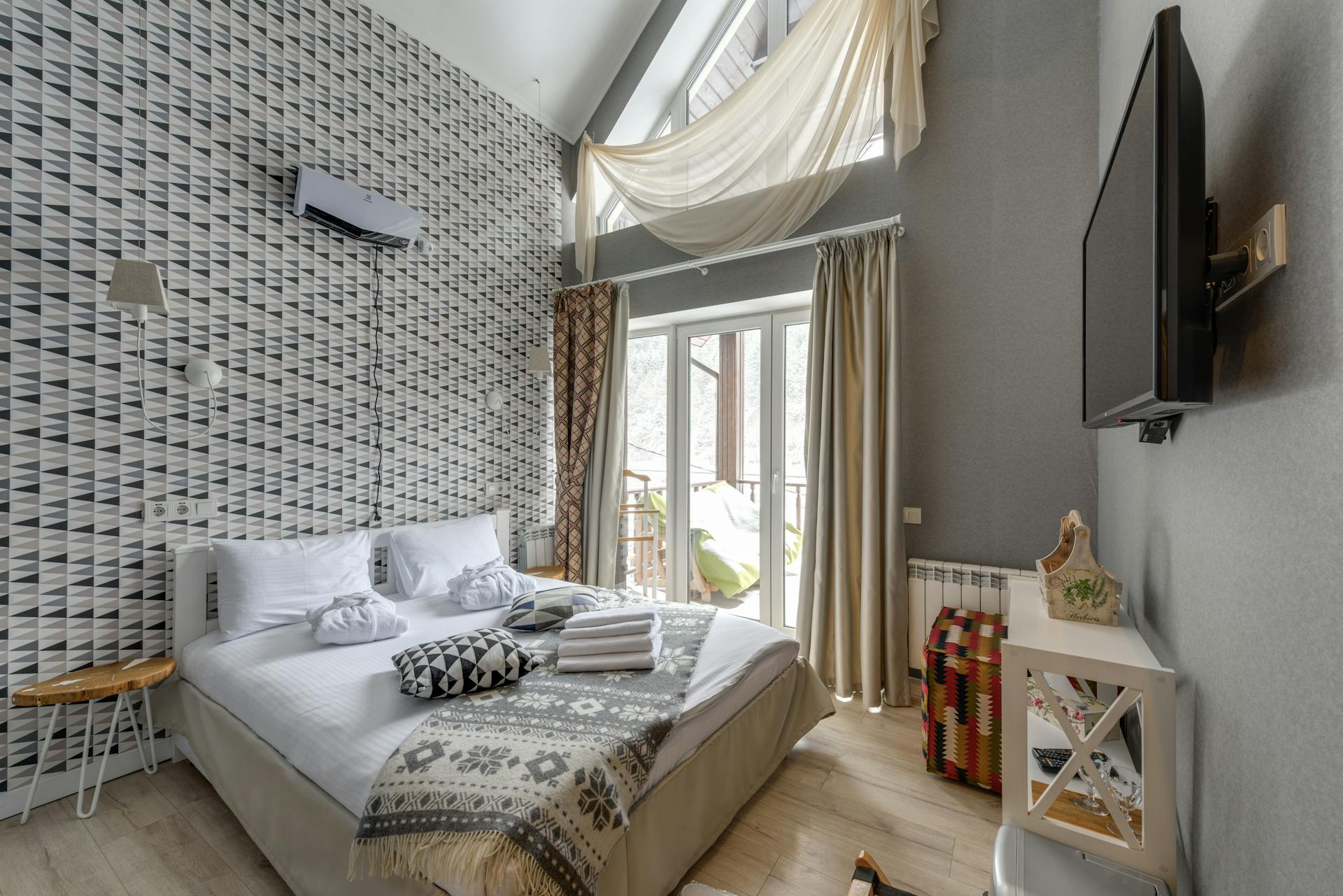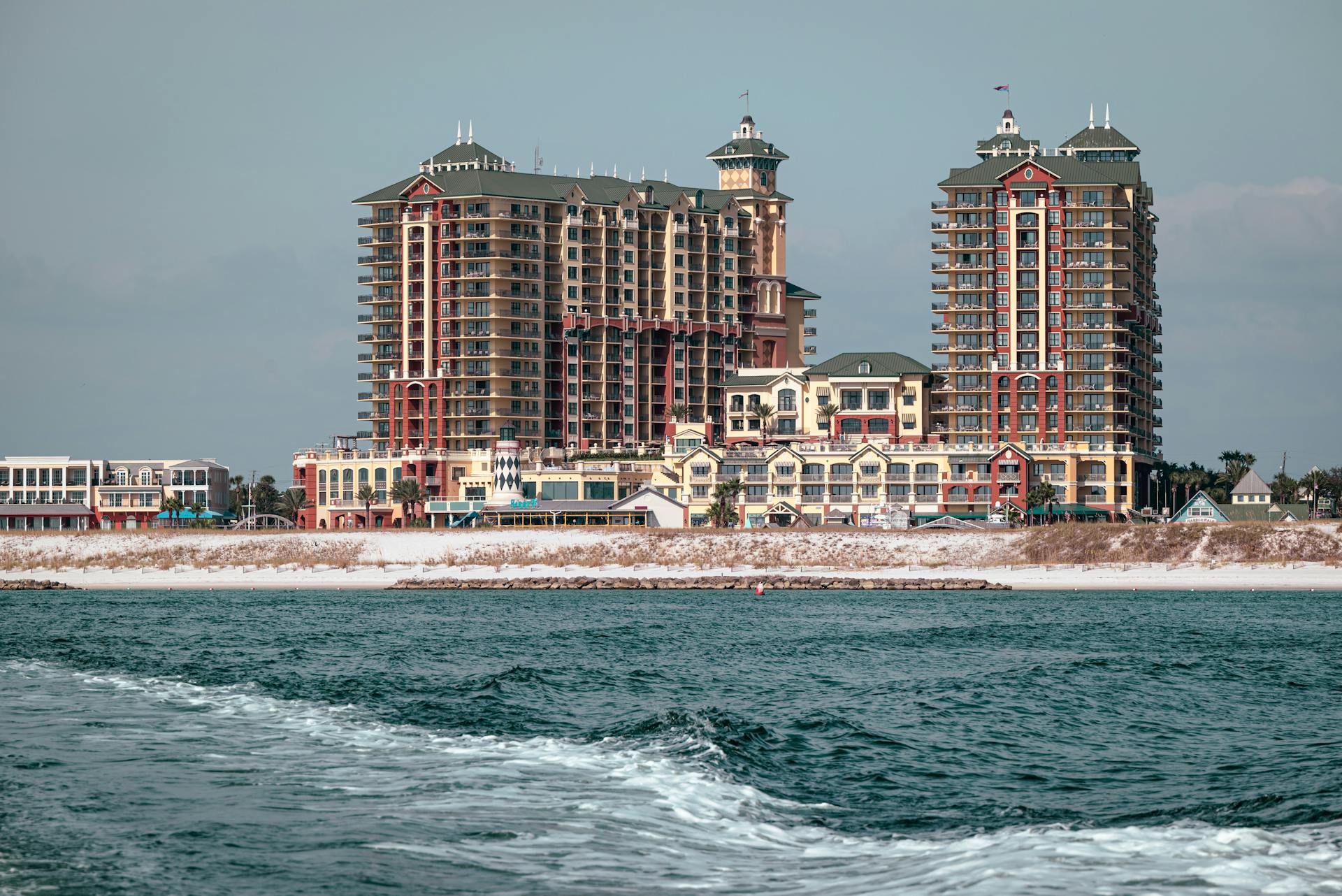
If you're a condo owner, you might be wondering if you need condo insurance. The truth is, it's highly recommended. Your condo association may have some coverage in place, but it's unlikely to be enough to fully protect you and your investment.
In fact, many condo associations only cover the common areas, leaving you responsible for your unit's interior and personal belongings. This means you could be on the hook for costly repairs or replacements if something goes wrong.
Condo insurance can help fill this gap, providing financial protection for your unit and its contents. It can also give you peace of mind, knowing you're prepared for unexpected events.
Understanding Condo Insurance
Your condo association's master policy will always protect the outside of the building, the elevators or stairs, and other common space. Some master policies may also cover the walls and fixtures inside your apartment, which reduces the amount of dwelling coverage you need to buy.
Intriguing read: Master Condo Insurance Massachusetts
If your master policy is "all in", it insures the interior and exterior surfaces of your unit, so you only need to worry about insuring the items you own. However, improvements can be a gray area.
You'll need to buy an individual policy to cover even the appliances or fixtures if your master policy is "bare walls in." This means everything inside of your apartment's four walls would need condo insurance.
Recommended read: Condo Walls in Insurance
What is HO-6?
HO-6 insurance is a policy form specifically designed for condominiums and co-ops, despite their different ownership structures.
The insurance policies for individual owners in condos and co-ops work pretty much the same way. You don't need to worry about the complexities of ownership structures when it comes to your insurance.
An HO-6 policy will cover your personal belongings in case of a covered peril or theft, including liability coverage if someone is injured in your home. This is similar to renters insurance, but you might be able to reduce your costs depending on what the master policy offers.
A fresh viewpoint: Who Is the Insured on a Life Insurance Policy
Your condo insurance should also include dwelling coverage, which can be extended to include any fixtures, appliances, or other permanent upgrades you've installed yourself. This is a crucial aspect of condo insurance.
Some master policies may cover the inside of your apartment, reducing the amount of dwelling coverage you need to buy. However, improvements can be a gray area, so it's essential to understand what's covered and what's not.
If your master policy is "all in", you don't need as much dwelling coverage. But if it's "bare walls in", you'll need to make sure the dwelling coverage you get is enough to replace all of the improvements attached to the surfaces.
For more insights, see: Condo Insurance Dwelling Coverage
Additional Living Expenses
Additional living expenses can be a significant burden when you're forced to move out of your condo due to repairs. This is where additional living expenses coverage, also known as loss of use coverage, comes in.
A burst pipe in your condo can cause you to have to move out for a couple of weeks, and your HO-6 policy can pay for hotel bills, restaurant meals, and laundry expenses that go beyond what you'd normally pay while living at home.
Suggestion: Medical Payment Insurance
Your condo insurance policy can help you cover these extra expenses, giving you peace of mind and financial stability during a difficult time.
A few weeks in a hotel can add up quickly, but with additional living expenses coverage, you can rest assured that you'll be able to afford the extra costs.
Top 5 FAQs
Here's the top 5 FAQs about condo insurance:
Q: What is condo insurance and why do I need it?
You need condo insurance to cover your personal belongings and liability in case of accidents or damage to your unit.
Q: What's the difference between condo insurance and homeowners insurance?
Condo insurance typically covers only the interior of your unit, while homeowners insurance covers the entire property, including the exterior.
Q: How much does condo insurance cost?
The cost of condo insurance varies depending on factors like location, coverage limits, and deductible, but on average, it can range from $300 to $1,000 per year.
Q: What's covered under a standard condo insurance policy?
A standard condo insurance policy typically covers damage to your unit's interior, personal belongings, and liability for accidents or injuries that occur on your property.
Q: What's not covered under a standard condo insurance policy?
A standard condo insurance policy usually doesn't cover damage to common areas, assessments, or losses due to flooding or earthquakes, which may require additional coverage.
Calculating and Updating Coverage
Calculating and updating coverage for your condo insurance can be a bit tricky, but don't worry, I've got the lowdown. Your condo association's master policy will always protect the outside of the building and other common space, but it may or may not cover the inside of your unit. If it does, that reduces the amount of dwelling coverage you need to buy.
Your mortgage lender may require a specific amount of dwelling coverage, which can vary even among top home loan providers. For example, one lender specified 20% of the unit's value, but this can vary. It's a good idea to clarify whether the requirement assumes an all-in or bare-walls-in master policy.
Consider reading: Condo Master Insurance
To estimate how much dwelling coverage you need, you can use a per-square-foot benchmark for comparable units. Alternatively, you can use estimates from your insurer or mortgage lender. For instance, to insure a 1,150 square-foot condo valued at $700,000, the range for dwelling coverage would be between $140,000 (20% of the unit's value) and $115,000 ($100 per square foot).
You should revisit and update your policy's coverage limits at least once a year. Three factors can cause your insurance needs to change: the cost of labor and materials, changes in real estate values, and the added value of any renovations you carry out. You can update the per-square-footage estimate for your condo's dwelling coverage when renewing your policy or comparing quotes from top insurers.
Here are some estimates to keep in mind:
- 20% of your unit's value: $140,000 ($700,000 x 0.2)
- $100 per square foot for regular and standard finishes: $115,000 ($100 x 1,150)
Remember, if a disaster happens and you're forced to rebuild the interior of your condo, you'll have to make up the shortfall yourself if your coverage limit isn't high enough.
Coverage Types and Scenarios
Your condo association's master insurance policy will cover the outside of the building, elevators or stairs, and other common space. Some master policies may also cover the walls and fixtures inside your apartment, which reduces the amount of dwelling coverage you need to buy.
If your master policy is "all in", you don't need as much dwelling coverage, but if it's "bare walls in", you'll need to make sure the dwelling coverage you get is enough to replace all of the improvements attached to the surfaces. This can be a gray area, especially when it comes to improvements.
Here are some common problems a typical individual condo insurance policy will and won't cover:
- Fire and smoke.
- Explosions.
- Wind and hail.
- Theft.
- Vandalism.
- Lightning.
- Burst pipe.
- Earthquakes.
- Flooding (i.e., heavy rainfall or storm surge).
- Intentional injuries to others.
- Nuclear hazards.
- Damage from birds, rodents and insects.
- Wear and tear.
- Damage from underground water (i.e., sewer backup).
What Cover?
Your condo association's master policy can be a lifesaver, but it's not a one-size-fits-all solution. Some master policies cover the interior and exterior surfaces of your unit, reducing the amount of dwelling coverage you need to buy.
If your master policy is "all in", you don't need to worry about insuring the interior of your unit, but if it's "bare walls in", you'll need to buy an individual policy to cover even the appliances and fixtures.
The type of master policy you have determines how much dwelling coverage you need. If it's "all in", you'll need less dwelling coverage, but if it's "bare walls in", you'll need to make sure the dwelling coverage you get is enough to replace all of the improvements attached to the surfaces.
Condo insurance generally covers your personal belongings and offers financial protection if someone sues you for negligence. It may also cover your unit's interior fixtures and appliances, depending on what your condo association's master insurance policy includes.
Here's a breakdown of what your condo insurance might cover, depending on your master policy:
- Damage to your unit's interior, including cabinetry, drywall, and fixtures, if your master policy is "bare walls in"
- Your personal belongings, such as clothes and furniture
- Financial protection if someone sues you for negligence
- Your unit's interior fixtures and appliances, if your master policy is "all in"
Medical Payments
Medical Payments can help cover medical bills for guests who get hurt in your condo. This coverage is usually separate from liability coverage and has a lower limit.
If someone is injured while visiting your condo, Medical Payments will cover reasonable and necessary expenses, up to the policy limits. This is true even if you're not at fault.
Medical Payments coverage is important if you often have guests over. For example, if a friend trips over an extension cord and breaks their wrist while visiting your condo, Medical Payments could help with their doctor bills.
Medical Payments typically cover medical expenses for invited guests who don't live with you. This is a key distinction from liability coverage, which requires you to be found responsible for the injury or property damage.
Frequently Asked Questions
Do most states require home or condo insurance?
No, most states do not require home or condo insurance, but lenders often mandate it for financed properties. However, standard insurance coverages are generally the same across all states.
Do you need homeowners insurance if you live in a condo?
Yes, condo owners typically need their own HO-6 policy to protect their personal unit and belongings. This fills gaps not covered by the condo association's master policy.
How much personal property insurance do I need for a condo?
For condos, assume $40,000 in personal property coverage for the first 1,000 square feet and add $5,000 for each additional 500 square feet. This general rule of thumb helps ensure you have adequate coverage for your belongings.
Sources
- https://www.valuepenguin.com/homeowners-insurance/how-much-dwelling-coverage-to-get-condo-insurance
- https://beresfordlaw.com/condominium-insurance-policies/
- https://www.scfbins.com/insurance/property-insurance/condo-insurance
- https://www.nerdwallet.com/article/insurance/condo-ho6-insurance
- https://www.lopriore.com/blog/renters-insurance-vs-condo-insurance/
Featured Images: pexels.com


